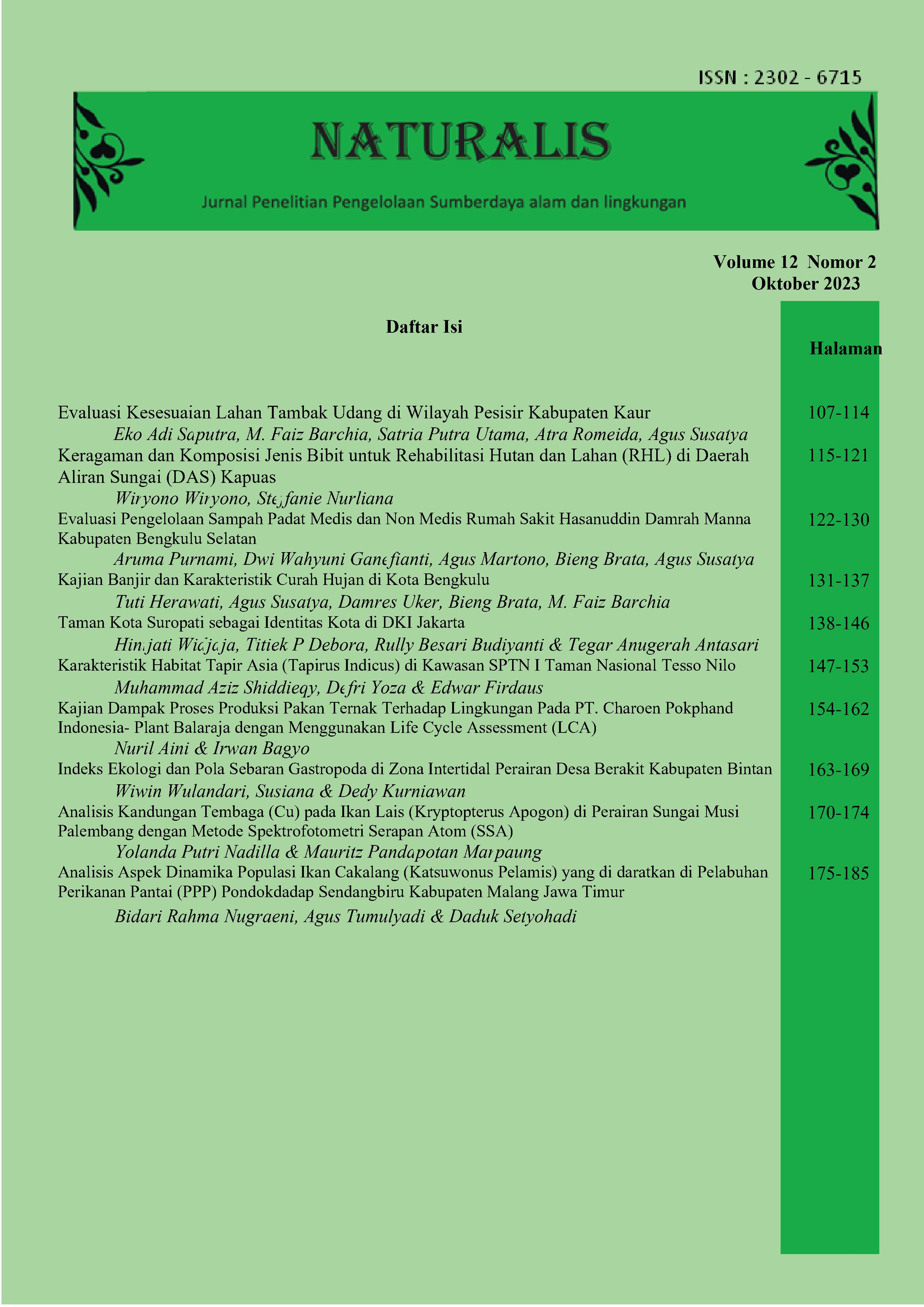Karakteristik Habitat Tapir Asia (Tapirus Indicus) di Kawasan SPTN I Taman Nasional Tesso Nilo
Abstract
Tapir Asia ( Tapirus indicus) is a plant-eating herbivorous animal (Goltenboth et al., 2012). Habitats that are suitable for survival, such as the availability of sufficient food and an environment that supports tapirs for breeding and resting which occupy places of life in the form of swamp habitats, lowlands, mountains, hill forests, secondary forests, dense shrubs and palm plantations (Ministry of Forestry, 2013). Tesso Nilo National Park is one of the natural forest areas that still provides a habitat for the continued preservation and rescue of rare animals, including the tapir. This study aims to determine the habitat characteristics of the Asian tapir (Tapirus indicus) in the SPTN I area of Tesso Nilo National Park. Determination of the position of the Asian tapir can be known by collecting data using direct and indirect observation methods. The habitat studied was selected using a purposive sampling technique, namely by exploring locations that are home ranges for tapirs. Observations were made using 1 transect line in each different habitat type. There are a total of 2 transect lines, there are 25 observation plots in each line so that a total of 50 observation plots. Habitat characteristics suitable for tapirs based on tree crown cover were 1.77% -14.14% shrubs and secondary forest tree canopy cover 17.68% -99.79%. Habitat characteristics for tapirs based on the availability of forage plant species are mostly found in shrub vegetation, 27.272% -96.55%. Based on the slope factor, the slope is at a level of 1% -21%, this is included in the flat and sloping category, then based on the altitude it ranges from 42.01 masl to 71.96 masl. The distance between secondary forest vegetation and natural forest is 810.89 m-1,220.43 m and the distance between shrub vegetation is 2,537.39 m-3,084.49 m and the distance from the river to secondary forest vegetation is 8.98 m-317.41 m and scrub vegetation 24.52 m-398.75 m.
Full text article
References
Fachrul, M. F. (2007). Metode sampling Bioekologi. Jakarta: PT Bumi Aksara.
Hadi, M.L. 19 Desember 2019. Komunikasi pribadi tentang konsumsi pakan tapir dan waktu makan tapir serta jarak dengan sungai pada aeral rehabilitasi hutan dan lahan Kasang Kuantan Mudik.
Indriyanto, D. (2008). Evaluasi properti (porositas, saturasi air dan permeabilitas) berdasarkan analisis log sumur “beta” pada formasi baturaja lapangan” biru” untuk penentuan zona prospek hidrokarbon cekungan sumatera selatan (Doctoral dissertation, Geological Engineering Department Engineering Faculty Diponegoro University).
IUCN, 2012. Tapirus indicus (Asian Tapir, Indian Tapir, Malayan Tapir, Malay Tapir). Available at: http://www.iucnredlist.org/details/21472/0. Diakses tanggal 17 Desember 2021.
Munawwaroh, A. 2016. Penerapan Analisis Vegetasi Di Hutan Mbeji Daerah Wonosalam Jombang. IKIP Budi Utomo Malang.
Peraturan menteri kehutanan. 2018. Arahan strategis konservasi spesies nasional 2008-2018. Kementerian kehutanan. Jakarta.
Peraturan mentri kehutanan. 2013. Strategi dan Rencana Aksi Konservasi Tapir. Jakarta: Menteri Kehutanan Republik Indonesia
Pitoy, C. V. (2016). Analisis strategi bersaing dalam persaingan usaha bisnis document solution (studi kasus pada PT. Astragraphia, Tbk Manado). Jurnal Berkala Ilmiah Efisiensi, 16(3).
Authors
Copyright (c) 2023 MUHAMMAD AZIZ SHIDDIEQY

This work is licensed under a Creative Commons Attribution-ShareAlike 4.0 International License.
An author who publishes in Naturalis agrees to the following terms:
Author retains the copyright and grants the journal the right of first publication of the work simultaneously licensed under the Creative Commons Attribution-ShareAlike 4.0 License that allows others to share the work with an acknowledgement of the work's authorship and initial publication in this journal
The author is able to enter into separate, additional contractual arrangements for the non-exclusive distribution of the journal's published version of the work (e.g., post it to an institutional repository or publish it in a book) with the acknowledgement of its initial publication in this journal. The author is permitted and encouraged to post his/her work online (e.g., in institutional repositories or on their website) prior to and during the submission process, as it can lead to productive exchanges, as well as earlier and greater citation of the published work (See The Effect of Open Access).
Submission of a manuscript implies that the submitted work has not been published before (except as part of a thesis or report, or abstract); that it is not under consideration for publication elsewhere; that its publication has been approved by all co-authors. If and when the manuscript is accepted for publication, the author(s) still hold the copyright and retain publishing rights without restrictions. Authors or others are allowed to multiply an article as long as not for commercial purposes. For the new invention, authors are suggested to manage its patent before published. The license type is CC-BY-SA 4.0.
Naturalis is licensed under a Creative Commons Attribution-ShareAlike 4.0 International License.

